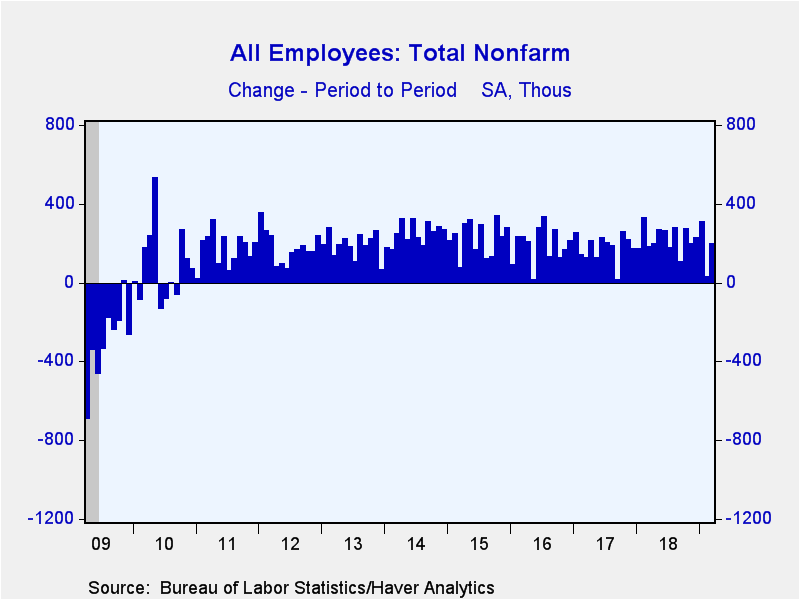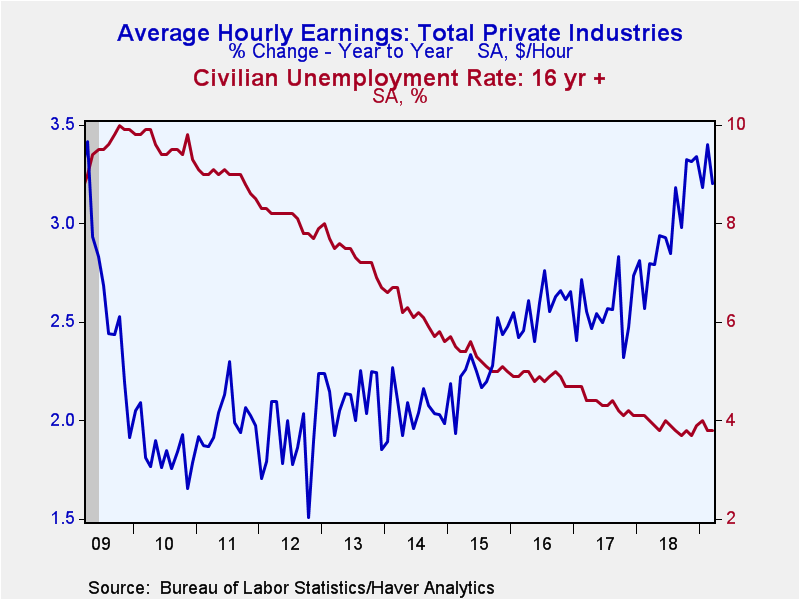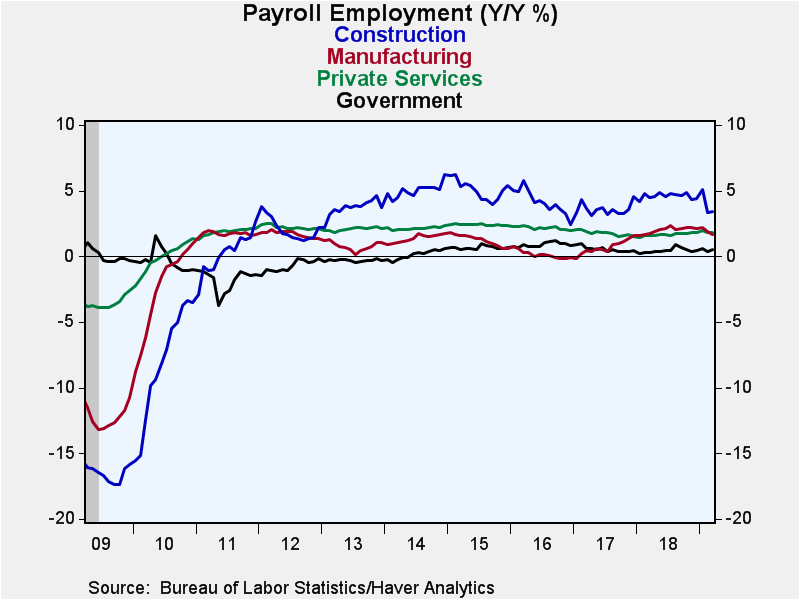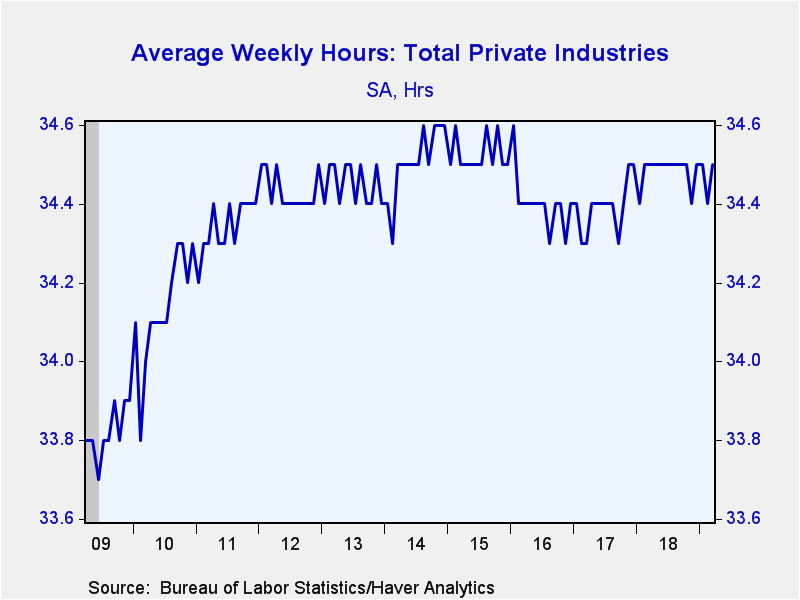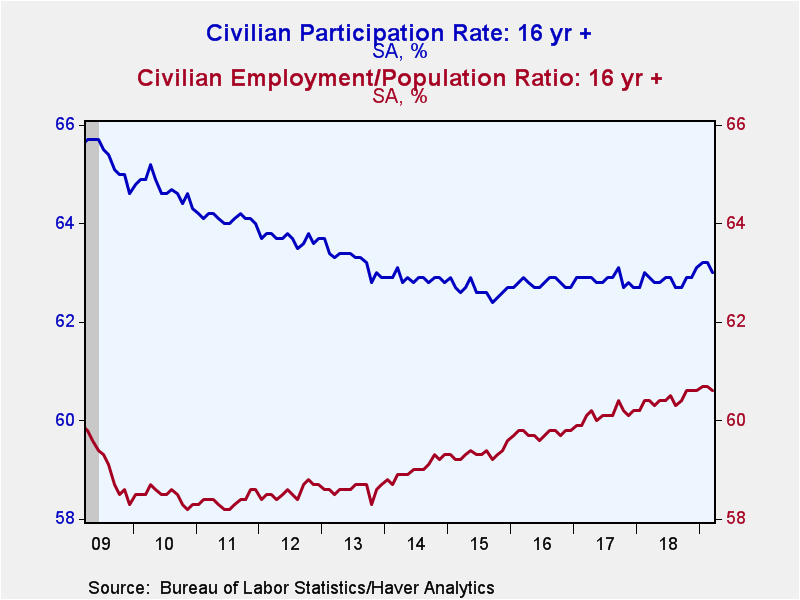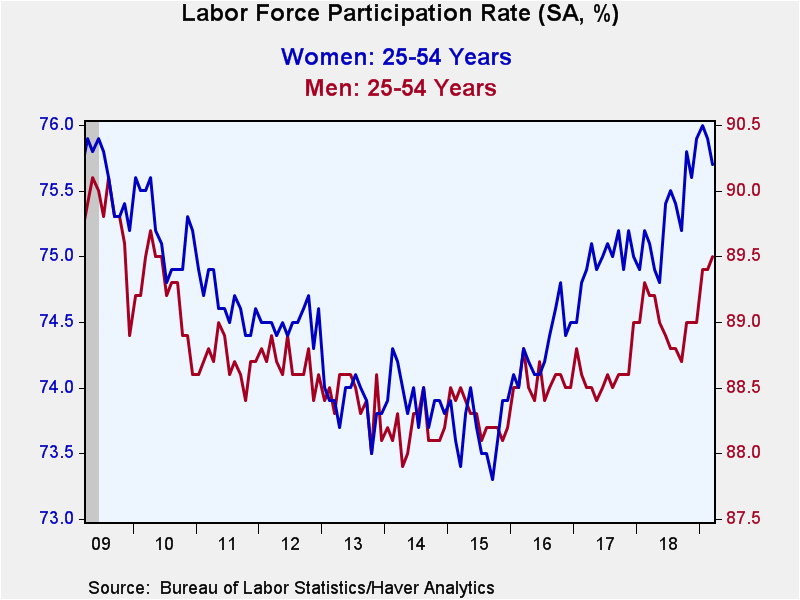 Global| Apr 05 2019
Global| Apr 05 2019U.S. Employment Growth Improves But Wage Growth Moderates; Unemployment Rate Is Unchanged
by:Tom Moeller
|in:Economy in Brief
Summary
The March jobs report added to other indications that economic activity perked up last month. After having been restrained by bad winter weather in February, auto sales, the ISM factory index and existing home sales each rose. [...]
The March jobs report added to other indications that economic activity perked up last month. After having been restrained by bad winter weather in February, auto sales, the ISM factory index and existing home sales each rose. Foreshadowing today's favorable report, initial unemployment insurance claims fell to a 49-year low.
Nonfarm payrolls increased 196,000 (1.7% y/y) during March following a 33,000 February rise, revised from 20,000. January's rise was little changed at 312,000. The March increase exceeded expectations for a 175,000 rise in the Action Economics Forecast Survey. Countering these positive readings was a minimal 0.1% uptick (3.2% y/y) in average hourly earnings which fell short of expectations for a 0.2% rise. It followed an unrevised 0.4% February gain.
The March unemployment rate held steady at an expected 3.8%. The overall jobless rate, including those who were marginally attached or working part-time for economic reasons, also was unchanged at 7.3%, the lowest level since March 2001.
From the payroll employment survey, the 196,000 jobs increase last month reflected a 16,000 rise (3.4% y/y) in construction jobs which followed a 25,000 decline. Factory sector employment fell, however, by 6,000 (+1.7% y/y) following a 1,000 increase. Mining sector employment rose by 1,100 (6.9% y/y) after a 1,500 decline.
Private service-producing jobs rose 170,000. It reflected a 70,000 increase in education & health services (2.3% y/y) which added to a 13,000 February gain. Leisure & hospitality jobs strengthened 33,000 (2.7% y/y) after a 1,000 decline. Professional & business services employment rose 37,000 (2.6% y/y) following a 54,000 rise. That lessened m/m gain included a 5,400 decline (+1.3% y/y) in temporary help employment which reversed the prior month's increase. Financial activities employment rose 11,000 (1.2% y/y) after a 6,000 gain. Jobs in the information sector improved 10,000 (-0.1% y/y) on the heels of declines in each of the four prior months. Employment in the trade, transportation & utilities category countered these increases with a 5,000 decline (+0.7% y/y) that added to a 15,000 shortfall. Within that category, retail trade jobs declined 11,700 (-0.3% y/y) after a 20,200 drop.
Employment in the government sector rose 14,000 (0.5% y/y) last month and added to a 5,000 February rise. The gain was held back by a 2,000 worker decline (+0.2% y/y) in federal government jobs which was the third decline in four months. A 12,000 increase (0.5% y/y) in local government employment offset the decline as it followed a 2,000 easing. State government jobs increased 4,000 (0.7% y/y) after a 6,000 increase.
The minimal 0.1% rise in average hourly earnings reflected a 0.2% decline (+1.8% y/y) in factory sector pay which followed a 0.6% upward spike in February. Construction earnings rose 0.2% (3.3% y/y), half the prior month's gain and service sector earnings also halved m/m to 0.2% (3.4% y/y. Strengthening, however, were information services sector earnings by 0.3% (6.1% y/y following a 0.1% dip. Earnings in trade, transportation & utilities also rose 0.3% (4.0% y/y) following a 0.5% rise. Professional & business services sector earnings rose a steady 0.5% (3.3% y/y) but financial activities earnings improved just 0.1% (3.3% y/y) after a 0.3% rise. Leisure & hospitality wages inched 0.1% higher (3.7% y/y), but that followed a 0.7% spike. Education & health services pay eased 0.1% (+2.2% y/y) after a 0.1% rise.
The length of the private sector average workweek increased to 34.5 hours, equaling the longest since January 2016. The mining sector workweek held at an increased 46.2 hours. The factory sector workweek steadied below the levels of the last two years at 40.7 hours. The construction sector workweek lengthened m/m to 39.4 hours, but it remained below the January level. The length of the private service sector workweek also was steady at 33.3 hours. The length of the financial sector workweek held at 37.7 hours and the information sector workweek increased to 36.3 hours. The professional & business services workweek lengthened to 36.3 hours and education & health services hours strengthened to 33.1 hours, a surge from the 2014 low of 32.6 hours. Hours in leisure & hospitality at 26.1 remained below the cycle high.
In the household unemployment survey, the unchanged 3.8% jobless rate reflected a 201,000 decline in employment accompanied by a 224,000 decrease in the size of the labor force. The 1.1% y/y rise in the size of the population-adjusted labor force reflected a diminished 63.0% labor force participation rate. The 82.5% labor force participation rate for individuals aged 25-54 years old reflected a rise in the rate to 89.5% for men in that age bracket and a lessened 75.7% for women of that age. The employment-to-population ratio of 60.6% was higher than the low of 58.2% averaged in 2011. Rough stability in the y/y change in the number of individuals not in the labor force compared to 2.0% y/y growth just six months earlier. The average duration of unemployment rose slightly to 22.2 weeks, nearly half the cycle peak.
The jobless rate for individuals without a high school diploma increased to 5.9%, but for high school graduates with no college, it eased to 3.7%. Individuals with some college but no degree were 3.4% unemployed. College graduates experienced a cycle low 2.0% unemployment.
By age group, teenage unemployment fell to 12.8% and for those aged 20-24 years it was 7.2%. Individuals aged 25-54 years old were 3.2% without work, while those over age 55 were 2.7% unemployed.
The labor market data are contained in Haver's USECON database. Detailed figures are in the EMPL and LABOR databases. The expectations figures are in the AS1REPNA database.
| Employment: (SA, M/M Change, 000s) | Mar | Feb | Jan | Mar Y/Y | 2018 | 2017 | 2016 |
|---|---|---|---|---|---|---|---|
| Payroll Employment | 196 | 33 | 312 | 1.7% | 1.7% | 1.6% | 1.8% |
| Previous Estimate | -- | 20 | 311 | -- | -- | -- | |
| Manufacturing | -6 | 1 | 17 | 1.7 | 2.0 | 0.7 | 0.1 |
| Construction | 16 | -25 | 56 | 3.4 | 4.6 | 3.6 | 4.1 |
| Private Service-Producing | 170 | 56 | 217 | 1.8 | 1.7 | 1.8 | 2.2 |
| Government | 14 | 5 | 15 | 0.5 | 0.5 | 0.6 | 0.9 |
| Average Weekly Hours - Private Sector | 34.5 | 34.4 | 34.5 | 34.5 | 34.5 | 34.4 | 34.4 |
| Private Sector Average Hourly Earnings (%) | 0.1 | 0.4 | 0.1 | 3.2 | 3.0 | 2.6 | 2.6 |
| Unemployment Rate (%) | 3.8 | 3.8 | 4.0 | 4.0 | 3.9 | 4.4 | 4.9 |
Tom Moeller
AuthorMore in Author Profile »Prior to joining Haver Analytics in 2000, Mr. Moeller worked as the Economist at Chancellor Capital Management from 1985 to 1999. There, he developed comprehensive economic forecasts and interpreted economic data for equity and fixed income portfolio managers. Also at Chancellor, Mr. Moeller worked as an equity analyst and was responsible for researching and rating companies in the economically sensitive automobile and housing industries for investment in Chancellor’s equity portfolio. Prior to joining Chancellor, Mr. Moeller was an Economist at Citibank from 1979 to 1984. He also analyzed pricing behavior in the metals industry for the Council on Wage and Price Stability in Washington, D.C. In 1999, Mr. Moeller received the award for most accurate forecast from the Forecasters' Club of New York. From 1990 to 1992 he was President of the New York Association for Business Economists. Mr. Moeller earned an M.B.A. in Finance from Fordham University, where he graduated in 1987. He holds a Bachelor of Arts in Economics from George Washington University.


